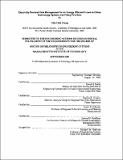| dc.contributor.advisor | Stephen R. Connors. | en_US |
| dc.contributor.author | Cheng, Chia-Chin | en_US |
| dc.contributor.other | Massachusetts Institute of Technology. Engineering Systems Division. | en_US |
| dc.date.accessioned | 2006-07-31T15:22:51Z | |
| dc.date.available | 2006-07-31T15:22:51Z | |
| dc.date.copyright | 2005 | en_US |
| dc.date.issued | 2005 | en_US |
| dc.identifier.uri | http://hdl.handle.net/1721.1/33679 | |
| dc.description | Thesis (Ph. D.)--Massachusetts Institute of Technology, Engineering Systems Division, 2005. | en_US |
| dc.description | Includes bibliographical references (p. 278-289). | en_US |
| dc.description.abstract | The main objective of this research is to identify robust technology and policy options which achieve substantial reductions in electricity demand in China's Shandong Province. This research utilizes a scenario-based approach to identify sensible and feasible energy efficiency and load reduction strategies. The research consists of technical analyses through the development of an hourly load simulation model to study the time and temperature sensitive impacts on electricity demand growth by different demand-side management (DSM) scenarios and a policy analysis to formulate policy priorities based on the socio-economic and environmental realities in China. This bottom-up comprehensive study helps inform decision-making given the technological, consumption and socio-economic conditions in large-scale electricity grid systems of Shandong and China, thus preferred DSM strategies are identified, and sensible policy recommendations are made with respect to Shandong province and China as a whole. This study developed a computer-based modeling tool for peak-load based electric demand analysis and long-term projections. | en_US |
| dc.description.abstract | (cont.) The model simulates disaggregated hourly electric loads by end-user types with temperature-sensitive load simulation capability, which takes into account time use patterns, life-style and behavioral factors, distributed consumption behaviors of electricity users, appliances and equipment utilization patterns, environmental factors, and industrial structural and operational parameters. The simulation and scenario based research methodology provides a comparative basis, and dynamic insights to electricity demand in areas when limited generation and consumption information is available, which is especially appropriate for electricity sector studies in developing countries. The research showed that demand side management strategies could result in significant reduction in the peak loads as well as the total electricity consumption in Shandong. | en_US |
| dc.description.abstract | (cont.) The results of the technical analysis concluded that (1) temperature sensitive load makes up the fastest growing demand within the entire consumption profile; (2) implementation of building energy efficiency strategies demonstrates the largest energy saving potential; (3) implementation of appliances standards, has limited effects on energy saving; (4) load management strategies to induce changes in consumption behaviors also shows great potential, however, they are difficult to estimate; and (5) urbanization policies also have a strong impact on electricity consumption. The recommended DSM policy priorities are based on the energy-saving potentials of the DSM strategies, which are listed in priority order: (1) improvement of building technology, (2) management of new installation first (3) management of temperature sensitive loads, (4) implementation of behavioral and load management strategies, (5) better management of urbanization policies (6) promotion of aggressive industrial motor substitution measures & industrial structural changes, and (6) improvement of appliance efficiency. | en_US |
| dc.description.abstract | (cont.) This research also formulated integrated DSM policy recommendations to the Chinese government that are centered by the development of coordinated DSM policy framework, and that are based upon the current technological, managerial and institutional capacities of Chinese industry and governmental agencies. The details include moving away from the traditional utility centered IRP/DSM framework, developing a robust energy efficiency services industry, setting correct DSM priorities and implementing them, developing and upgrading the domestic energy efficiency product industry, and engaging end-user participation. The thesis recognized the barriers and difficulties in the policy implementation and stressed the importance of continuous adaptation and institutional learning in the implementation process. | en_US |
| dc.description.statementofresponsibility | by Chia-Chin Cheng. | en_US |
| dc.format.extent | 361 p. | en_US |
| dc.format.extent | 25408809 bytes | |
| dc.format.extent | 25424837 bytes | |
| dc.format.mimetype | application/pdf | |
| dc.format.mimetype | application/pdf | |
| dc.language.iso | eng | en_US |
| dc.publisher | Massachusetts Institute of Technology | en_US |
| dc.rights | M.I.T. theses are protected by copyright. They may be viewed from this source for any purpose, but reproduction or distribution in any format is prohibited without written permission. See provided URL for inquiries about permission. | en_US |
| dc.rights.uri | http://dspace.mit.edu/handle/1721.1/7582 | |
| dc.subject | Engineering Systems Division. | en_US |
| dc.title | Electricity demand-side management for an energy efficient future in China : technology options and policy priorities | en_US |
| dc.type | Thesis | en_US |
| dc.description.degree | Ph.D. | en_US |
| dc.contributor.department | Massachusetts Institute of Technology. Engineering Systems Division | |
| dc.identifier.oclc | 64584147 | en_US |
